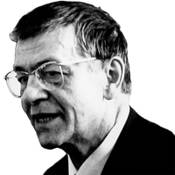
public domain
Peter Weiss
Playwright
Biography
Peter Weiss
Peter Weiss was a German playwright, author, and painter. He was the son of a textile manufacturer who was Jewish by origin but Christian by conversion. In 1934 he and his family were forced into exile by Nazi persecution. Weiss lived in England, Switzerland, and Czechoslovakia before settling in Sweden in 1939. As a young man, he painted and made experimental, Surrealist-influenced films. Weiss also illustrated a Swedish edition of the Thousand and One Nights. He then turned to fiction and drama, and his early works were in Swedish. By 1950 he began publishing in German.
Weiss is perhaps best known for his 1964 play, Die Verfolgung und Ermordung Jean Paul Marats, dargestellt durch die Schauspielgruppe des Hospizes zu Charenton unter Anleitung des Herrn de Sade (The Persecution and Assassination of Jean-Paul Marat as Performed by the Inmates of the Asylum of Charenton Under the Direction of the Marquis de Sade), usually referred to as Marat/Sade. Later plays also include Die Ermittlung (The Investigation; 1965), Gesang vom lusitanischen Popanz (The Song of the Lusitanian Bogey; 1967), and Viet Nam Diskurs (Discourse on Viet Nam, 1968).
Weiss also wrote three autobiographical novels: Der Schatten des Körpers des Kutschers (The Shadow of the Body of the Coachman; 1960), Abschied von den Eltern (The Leavetaking; 1961), and Fluchtpunkt (Exile; 1962). His magnum opus was the three volume novel Die Ästhetik des Widerstands (The Aesthetics of Resistance_; 1975-1981), which dramatizes anti-fascist resistance and the rise and fall of proletarian political parties in Europe. Weiss won the Charles Veillon Prize for Fluchtpunkt in 1963 and the Georg Büchner Prize in 1982.
Shows
Shows associated with Peter Weiss
Monologues
Monologues from shows associated with Peter Weiss
Scenes
Scenes from shows associated with Peter Weiss
Quizzes
Quizzes associated with Peter Weiss
Learning Modules
Learning modules associated with Peter Weiss
Additional Information
N/A